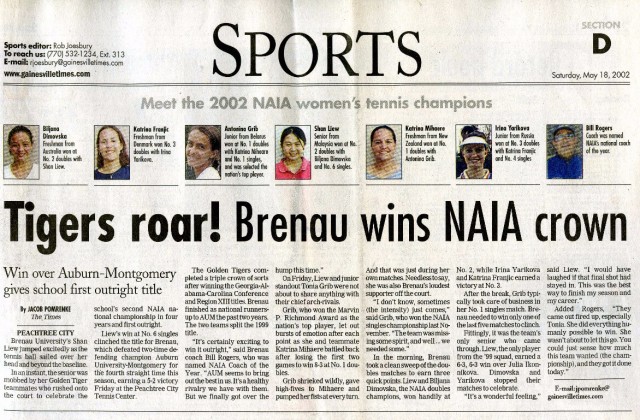Heavy Hitter
When you read about 2014 Brenau Athletics Hall of Fame inductee Antonina Grib Lerch’s days as the top U.S. collegiate singles tennis player, her competitors share one common denominator. Whether they played on NAIA or NCAA Division II or III players, she generally beat them all.
Since then the tennis champ has continuously moved up in rankings of her career in the Hollywood costume design world, but she has never wavered in support for her alma mater. Now she is paying back Brenau in other ways, too, including a significant contribution to the ForeverGold campaign.
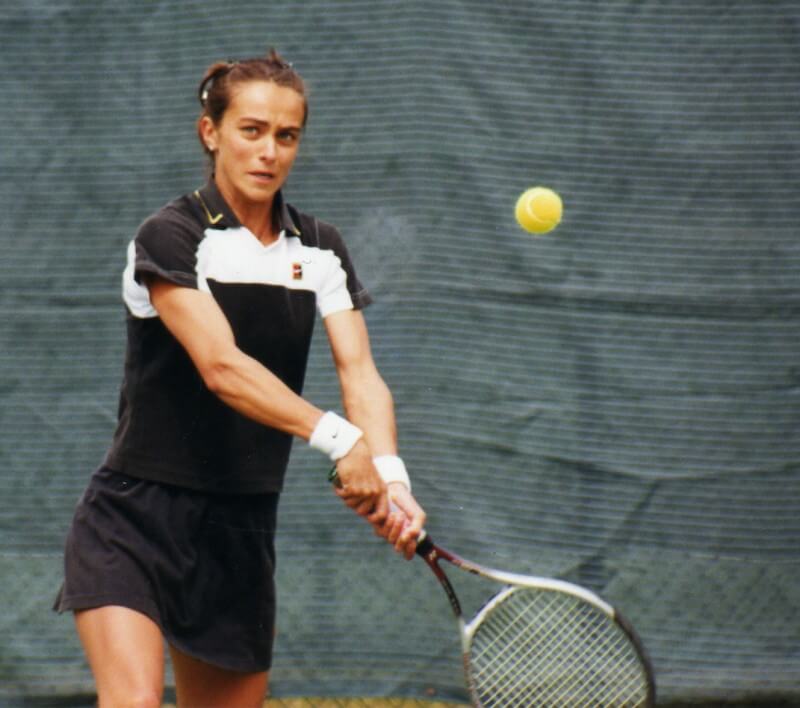 A press release from Wake Forest University in 2002 bragged that the NCAA Division I school’s top player was honored at Forest Hills, New York’s famed West Side Tennis Club as a member of the Tennis Week/Intercollegiate Tennis Association Collegiate All-Star Team. That team included players from other institutions, such as UCLA, Stanford, University of Florida and Brenau University. That last one was Antonina Grib, WC ’03.
A press release from Wake Forest University in 2002 bragged that the NCAA Division I school’s top player was honored at Forest Hills, New York’s famed West Side Tennis Club as a member of the Tennis Week/Intercollegiate Tennis Association Collegiate All-Star Team. That team included players from other institutions, such as UCLA, Stanford, University of Florida and Brenau University. That last one was Antonina Grib, WC ’03.
Now using her married name of Antonina Grib Lerch, the Golden Tiger “racketeer” that year appeared in this luminous company because she simply had beaten out a lot of people from all sizes of schools to win her third straight “Super Bowl” title as the national champ in women’s singles play. She remains the only collegian in history with that accomplishment.
Lerch started the record-setting run in her first year at Brenau. In the 2000 championship series of Oct. 19-22 in Memphis, Tennessee, the native of Belarus lost just 13 games in 10 sets, all of which she won, and across five matches, all in her win column, too.
That made the 5-foot, 6-inch tall Lerch the second Brenau player to win the “Super Bowl” since 1995. Fellow 2014 Golden Tiger Hall of Fame inductee Laurence Neuville won back-to-back titles in ’95 and ’96. As a Brenau senior, Lerch was the odds-on favorite to win a fourth title, but as we true-believer Golden Tiger enthusiasts might moan, “She was robbed!”
The National Association of Intercollegiate Athletics that year tightened its rules on amateur status. Lerch and others who had played as amateurs in professional tournaments (expenses were paid, but prize money wasn’t), or who’d grown up in countries that financially supported athletes as they developed from childhood, were rendered ineligible to compete when the NAIA imposed a $1,000 cap on remuneration regardless of expense.
According to press reports, the NAIA investigated Lerch’s expense-to-remuneration ratio back to the time she was 10 years old, but it found nothing that would indicate any breach in long-standing amateur status. The league a year later rescinded its stringent cap, but it did not re-instate the eligibility of the athletes, including that of Lerch. She did not get to play during her senior year at Brenau.
Natural Fit
Lerch, who is now 37, came to the United States from Minsk in the former Soviet Republic that declared its independence in 1991 when she was turning 13. She had abandoned her early desire to go to medical school to enter the state-sponsored athletics program to advance her education and take advantage of her natural gifts.
“In my country,” she told a group of Brenau students gathered around her in the fashion design lab in the Burd Center for Performing Arts when she returned to campus this fall for the Hall of Fame induction, “you either studied or you played tennis. You didn’t do both.” She chose the athletics path before she was a teenager. However, she added, she pretty well ruled out gymnastics as a pursuit because insofar as that sport was concerned, “I had a ‘late start.’ I was almost 9 years old when I began.”
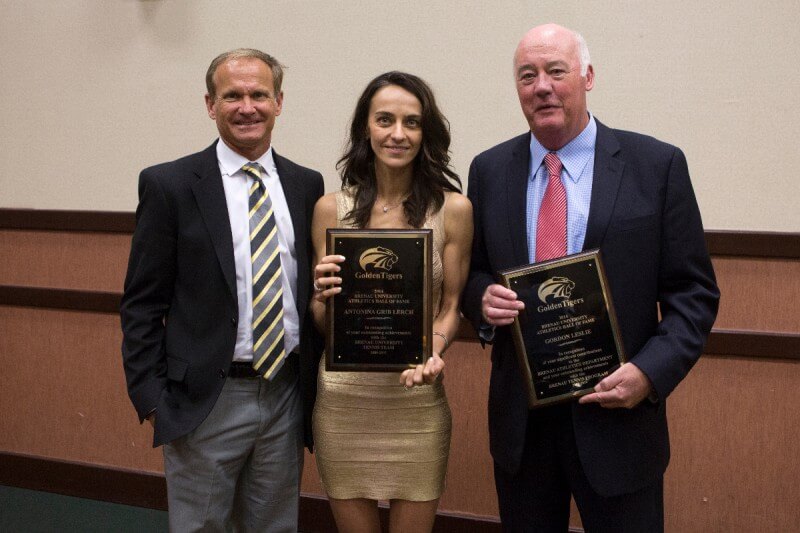
At the specialized high school for athletes, she explained, “they fed you, they trained you and, after that, if you were part of the national team, you got to travel.”
Her father, a taxi driver, had played some tennis in his day, so when his daughter picked up a racket, it was a natural fit. After making a name for herself as a teen player in Belarus, Clemson University recruited her to play for its Tigers, but a National Collegiate Athletic Association eligibility snafu forced her to look to the then-looser NAIA. Coming off the team’s 1999 national championship season at the time, Bill Rogers, Brenau’s tennis coach at the time, saw her play only once, but it was enough to convince him to offer her a full scholarship. He would say later that she had “the best racket head speed of any player I’ve ever coached, maybe any college player I’ve ever seen.”
In addition to her unprecedented and unmatched national championships, she was a three-time NAIA All-American selection and a member of both the 2000 and 2001 teams that were NAIA national runners-up and the 2002 national championship team. In 2000, she received ITA Player of the Year to Watch award, Georgia-Carolina-Alabama Female Athlete of the Year in 2001, following by two back-to-back Marvin P. Richmond Outstanding Player awards.
‘Sewing’ Seeds for Future
Tennis laurels, however, have not been her only contribution to Brenau.
When she was growing up, her mother, an engineer at a refrigerator factory, taught her to sew. Most was necessity, like re-cutting hand-me-downs to fit, be she also applied her own artistic flourishes, making fashion design projects from what for others might have been mere alterations. That came in handy. After the collapse of the Soviet Union, money was scarce in places like Belarus for supporting previously “blank check” athletics programs, and in scenes reminiscent of Scarlett O’Hara’s turning Yankee-ravaged Tara’s once-grand draperies into a stunning ball gown in the 1939 movie, Lerch made tennis costumes out of bed sheets.
During her first year at Brenau, as she followed the daily routine of getting up early to work out, going to class and playing tennis, she passed a room in the gymnasium that was full of sewing machines, “and I wondered what was going on.” It was the lab for Brenau’s fashion program, and Lerch settled on fashion merchandising as her major. One of her professors, Janet Smith Morley, encouraged her to work in the music, theater and dance departments as a costumer for various productions. For her practicum, she got involved with the Gainesville Theatre Alliance program, making costumes in an old electric room that doubled as the costume shop.
“She was simply amazing,” says Jim Hammond, the GTA director who attended Lerch’s “master class” with students in the Burd Center fashion design lab. “She would show up in the morning with an apple, and by the end of the day, she would have 12 costumes built.”
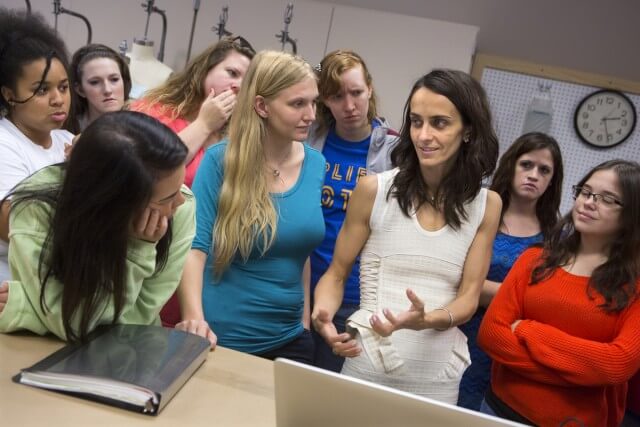
Lerch loved “how wonderful the school was for the arts,” and she loved more how Brenau developed the close interconnection. Her early work with theater, dance and music programs that coupled with the academic training she received enabled her to tap into her artistic side. It was a perfect match.
“When I told a friend at home that I was a costumer,” Lerch recalled, “she said ‘Knowing you, that makes perfect sense’.”
Hollywood, Ho!
After graduation, Lerch enrolled in a University of Georgia graduate program where she concentrated more specifically on designing clothing for theatrical productions. From there, in the Master of Fine Arts program, “everything just lined up.” At UGA, she learned, she said, about everything that related to theater: costume, lighting and scene design, directing and makeup. She tapped into the university’s Hargrett Library trove of more than 6,000 original costume design renderings from Broadway shows, movies and television to hone her research and design skills. She created and took advantage of every chance for practical experience, including internships with Georgia Museum of Art in Athens, Alliance Theater in Atlanta, Seaside Music Theater in Daytona Beach, Florida, and Perpetual Motion Films, a movie and television production company in southern California. She studied at the university under Sylvia J. Hillyard Pannell, who was also a mentor of Brenau’s current fashion design professor Lori Gann-Smith.
In Belarus, her first exposure to America was through the television soap opera, Santa Barbara, on Russian TV. “At 7 p.m., when that show was on, nobody was on the streets. They all wanted to know ‘What will Lionel do next? Did he marry Augusta again? What’s Sophia up to?’”
As she prepared to move to Hollywood to ply her new trade, she reached out to Diana Eden, who had been a costume designer early in the television series. Eden not only gave her some advice about getting started, but also mentored Lerch when the fledgling designer arrived in Los Angeles. “Diana literally took me by the hand and showed me the whole industry,” Lerch said.
Eden, working as a designing assistant on a new film starring Nicolas Cage and Elijah Wood, took an unusual break in the wardrobe trailer from the frenetic pace of her work. She dashed off a few comments about what caused her to “sit up and pay attention” to Antonina’s first e-mails from the many, many messages she receives from young people seeking entre into the business.
“Her story stood out and captured my imagination,” said Eden. Following about a year of correspondence, Eden got Lerch a summer internship on the NBC’s daytime drama, Passions.
“With her frail bone structure, I did not immediately picture a tennis champion,” said Eden, “until I looked at her strong arms and back. I soon learned that her spine and character were every bit as strong.”
As it happened, Lerch arrived at the end of her cross-country jaunt on the day of an all-night shoot at Universal Studios.
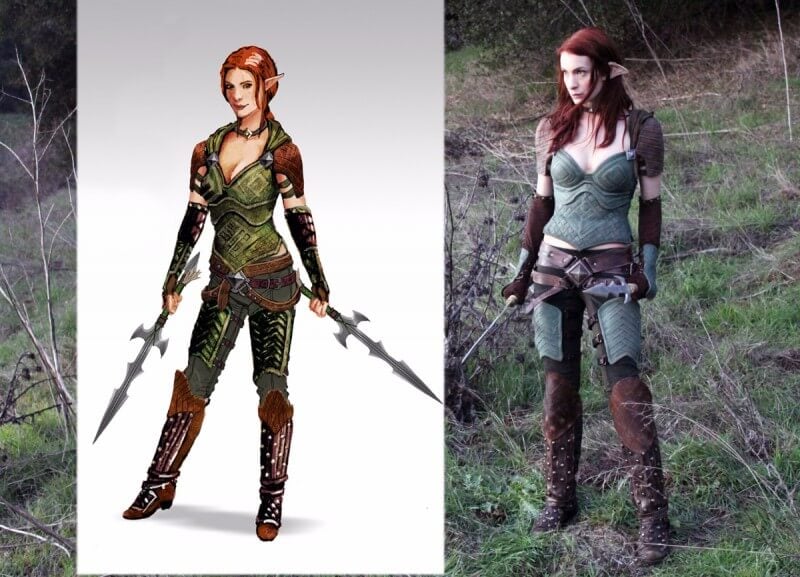
“I enjoyed her divine laugh, her generosity, but most of all, I was impressed by her enormous hunger for knowledge. She was not one for a sense of entitlement, and I never for one minute doubted that she would work with full commitment toward her goals – even when she was not entirely sure of them.” And, Eden added, she charged into her career “with the same drive and discipline she must have always had to be a tennis champion. She still impresses me with her desire to expand her base of knowledge in all things costume, textile, crafts, patterning, and more, and the lengths she will go for that knowledge, traveling the country and overseas to take workshops and find mentors. I am so grateful to have had her in my life, and I could not love her more if she were my own daughter. I am proud of her and all her accomplishments, and pleased to see her so happy with her husband and family.”
Cutting and Fitting
Antonina is married to Michael Lerch, a former Princeton University record-setting, All-Ivy-League wide receiver on that university’s Tigers football team, who is founder and chief investment officer of Los Angeles-based Evolution Capital Management, which does extensive work in Asia.
The Lerches, including their three Golden Retrievers, now divide time between Tokyo, their new home in Olympic Valley on the California side of Lake Tahoe, and Los Angeles. She takes advantage of her time in Tokyo to further her education in art and clothing design and technology, while running her own LA-based business, Firebird Costumes LLC, which specializes in building bespoke costumes.
After having worked at most major Hollywood studios as a cutter/fitter and specialty costume craftsperson on award-winning television programs like Mad Men, Dollhouse, Dexter and True Blood and on motion pictures like Night at the Museum II (2009) and Star Trek (2009) Antonina incorporated her own apparel-making business in 2012.
According to Fred Lloyd, Brenau’s technical theater professor and costume designer, a “cutter/fitter – in lay terms, a pattern maker – is a senior position in the costume design and production aspect of theatrical and film/television productions.
“The cutter/fitter works from the actor’s measurements and the costume rendering, the picture produced by the designer of what the costume is to look like,” added Lloyd. The design part is what Brenau Academy alum Janie Bryant, A’85, did for her Emmy-winning work in the HBO series Deadwood and what she has been doing on the costume-oriented series Mad Men. “The cutter/fitter,” Lloyd said, “uses those drawings and specifications to create the ‘blueprint’ of the costume. It requires careful training and an artistic mind, and yes, it is a really good position in the business.”
It is a fast-paced job, Lerch told the Brenau students. It is not an uncommon occurrence, she said, that “I will get a call one day telling me that an actor needs a specific costume. I don’t know who the actor is or what size the actor is, but the designer is going to send me the designs, some of which might have been done that day on a cocktail napkin, and tell me we need to build it for the next day’s shoot.”
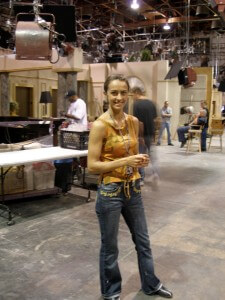
She gave the students some practical information, like the necessity and advantages of affiliating with the costumers union in Los Angles, which feeds in to the Designer’s Guild. She explained that the one-time sacrosanct hierarchy in the costume world is dying off for two reasons. First, the work has become so broad that it flows through highly specialized teams assembled for specific projects.
Second, much of the work for movies and television has moved away from Hollywood and Los Angeles because film and television production is growing significantly in places like Georgia and other locales. Another hot area now is Louisiana. She had to turn down work on a Harrison Ford movie, Ender’s Game, because she was getting married at the time and all the work was going to be in New Orleans. A friend of hers in Los Angeles got the job and, after the film was completed, never left New Orleans because of the abundance of work available there now in the industry.
In film, every day is different, but eight-hour days are a rarity. Lerch said the longest single day she had in her career was a 23-hour stretch.
“There are a lot of good things about the business,” she told the students, “but it sometimes has some dark and nasty aspects, so you really have to know what you are doing all the time.”
She encouraged students not to delay in expanding their artistic capabilities and knowledge about fashion and design and to stay ahead of mastering technical skills as they evolve like 3-D modeling and using software like design and photo editing software.
“The business is so huge and so geographically diverse that you can find something you love in a place you want to live,” she said. “I have never had trouble finding a job. There are always people who need something made.”
Giving Back

Shortly after her visit to Gainesville in the fall of 2014, Lerch contacted Brenau President Ed Schrader with a proposition for a gift to Brenau. Following their discussions, she specified that half would go to needs within the Golden Tigers tennis program. As for the other half, she pointed out opportunities to upgrade equipment and supplies to a more professional level within the theater department’s costume shop, but left actual acquisitions to the discretion of faculty and staff.
However, she did not stop at only giving money. Lerch also stated in her donation letter that she wanted to stay engaged with her alma mater. She offered to host practicum classes for Brenau’s technical theater and fashion design students at her studio in Los Angeles “where I can share with them what I have learned over the years working in Hollywood and have Brenau students practice in my shop.”
Although she left it to Lloyd’s discretion as to what to buy with the funds earmarked for the costume program, she also sent Lloyd and Schrader a detailed inventory of the kinds of things that would be important for the school to have in preparing students for professional practices in her field. That included some explanations of why exactly those things are important – a list that ranges from expensive industrial-grade sewing machines to Japanese scissors that you can get on eBay.
Lerch, says Schrader, represents “the perfect storm of higher education institution donor qualities, sharing her wealth, time and expertise.”
“She is exceptionally talented and richly experienced alumna,” Schrader said. “I think she is going to be an essential voice in Brenau’s future. I know the students and faculty she encountered during her visit here were inspired and excited in learning from her. We want to see that continue.”
